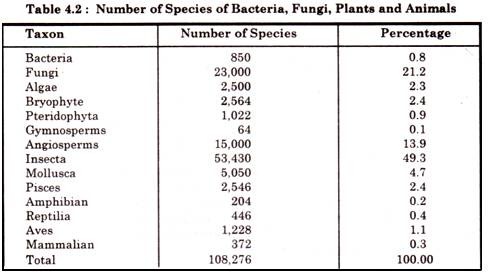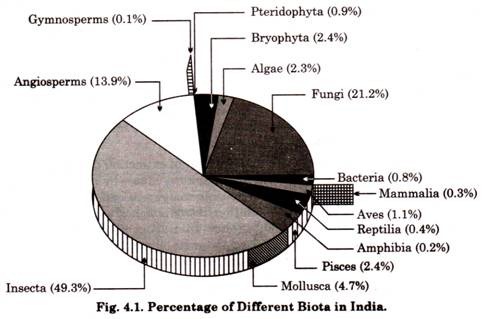Biodiversity at global, national and local levels
Global Level:
Conservative estimates of the existing biodiversity is ten million species, but if estimates for insects are correct then it could be around 30 million species, we have till now enlisted about 1.4 million species.
It includes among others about 98% birds, 95% reptiles and amphibians, 90% fish and about 85% higher plants known to exist on this Earth (Table 4.1)

National and Local Level:
India has over 108,276 species of bacteria, fungi, plants and animals already identified and described (Table 4.2). Out of these, 84 percent species constitute fungi (21.2 percent), flowering plants (13.9 percent), and insect (49.3 percent). In terms of the number of species, the insecta alone constitute nearly half of the biodiversity in India (Fig 4.1).
These species occur on land, fresh and marine waters, or occur as symbionts in mutualistic or parasitic state with other organisms. In the world as a whole, 16, 04,000 species of Monera, Protista, Fungi, Plantae and Animalia have been described so far. However, it is estimated that at least 179, 80,000 species exist in the world, but as a working figure 122, 50,000 species are considered to be near reality. Percentage of Different Biota in India

India is 10th among the plant rich countries of the world, fourth among the Asian countries, eleventh according to the number of endemic species of higher vertebrates (amphibia, birds and mammals), and tenth in the world as far as richness in mammals is concerned. Out of the 10 ‘Hot spots’ identified in the world, India has four. These are Eastern Himalaya, North East India, Western Ghats and Andaman & Nicobar Islands.
The crops which first grew in India and spread throughout the world include rice, sugarcane, Asiatic vignas, jute, mango, citrus, and banana, several species of millets, spices, medicinal, aromatics and ornamentals. India ranks sixth among the centres of diversity and origin in terms of agro-biodiversity.


